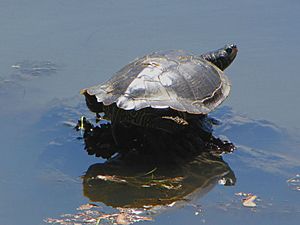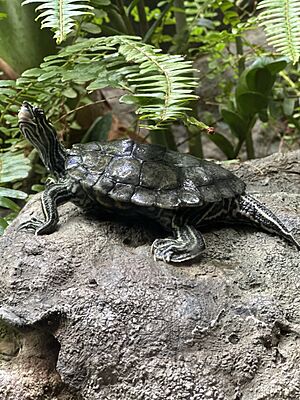Northern map turtle facts for kids
Quick facts for kids Northern map turtle |
|
|---|---|
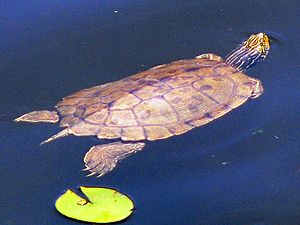 |
|
| Gatineau, Quebec | |
| Conservation status | |
| Scientific classification | |
| Genus: |
Graptemys
|
| Species: |
geographica
|
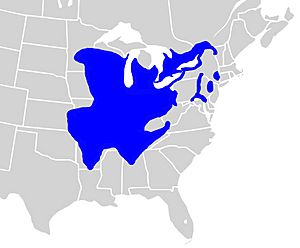 |
|
| Range map | |
| Synonyms | |
|
|
The northern map turtle (Graptemys geographica), also called the common map turtle, is a type of turtle that lives in water. It belongs to the family called Emydidae. This turtle is found only in North America.
Contents
What the Northern Map Turtle Looks Like
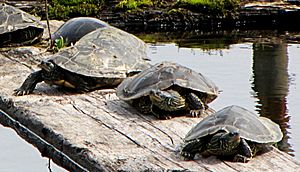
The northern map turtle gets its name from the special markings on its top shell, called the carapace. These markings look a lot like the lines you see on a map! They are usually yellow, tan, or orange, with dark edges. The rest of the shell is often olive green or brownish-grey.
As the turtle gets older, these map-like patterns can fade. Sometimes, you can only see them clearly when the shell is wet. The top shell is smooth and wide, with a small ridge down the middle. The back edge of the shell is flared and has jagged edges.
The bottom shell, called the plastron, is yellowish. It often has a dark mark in the center that also fades as the turtle grows older. Many older turtles have a plain, unmarked plastron.
The turtle's head, neck, legs, and tail are dark green with thin yellow stripes. There's also a round or triangle-shaped yellow spot behind each eye.
Size Differences Between Males and Females
Northern map turtles show a big difference in size between males and females. This is called sexual size dimorphism.
- Males are much smaller, usually about 10 to 16 centimeters (4 to 6 inches) long. They weigh between 150 to 400 grams (5 to 14 ounces).
- Females are larger, growing to about 18 to 27 centimeters (7 to 11 inches) long. They can weigh from 0.67 to 2.5 kilograms (1.5 to 5.5 pounds).
Females also have a much wider head than males. This helps them eat different kinds of food. Males have a narrower shell, a more noticeable ridge on their shell, and a longer, thicker tail. Young map turtles have a very clear ridge on their back. When they hatch, baby turtles are about 2.5 centimeters (1 inch) long and have a round, greyish-brown shell.
Where Northern Map Turtles Live
Northern map turtles live in an area stretching from southern Quebec and Ontario in Canada, down to northern Vermont in the United States. Their home includes the St. Lawrence River area. They also live west through the Great Lakes region, into southern Wisconsin and eastern Minnesota. Their range goes south to Kansas and northwestern Georgia. You can also find them in the Susquehanna River system in Pennsylvania and Maryland, and the Delaware River.
There's even a small group of these turtles in the Czech Republic in Europe. These turtles likely came from pets that escaped or were released. In the Czech Republic, they are considered an outside species.
Northern Map Turtle Habitat
Northern map turtles live in ponds, rivers, and lakes. They like large bodies of water and places with lots of fallen trees or other debris. These spots are perfect for them to bask in the sun. You'll often find them more in rivers than in lakes or ponds. In the northern parts of their range, they prefer bigger rivers and lakes. But in the south and west, they might live in smaller, rocky rivers and streams. Like all turtles, they need sunlight to stay healthy and warm.
Northern Map Turtle Behaviour
Northern map turtles become inactive from November through April. The exact timing depends on the weather where they live. During winter, they stay underwater and don't come up to breathe, especially when there's ice on the surface. Adult turtles rest on the bottom or hide under rocks or logs. They often hibernate together in groups.
Their winter hiding spots, called hibernacula, must have plenty of oxygen in the water. Unlike some other turtles, like painted turtles, map turtles need to take in oxygen from the water to survive the cold months.
These turtles usually bask in groups, soaking up the sun's rays. They are diurnal, meaning they are active only during the daytime. Northern map turtles are also quite shy. If they sense danger, they quickly slip into the water and hide.
Northern Map Turtle Life Cycle
Northern map turtles mate in the spring and fall. Most mating happens in deep water. The time when females lay their eggs, called the nesting period, is from May to July. They prefer sunny spots with sandy soil for their nests. The female digs a nest hole using her back feet.
A female usually lays between six and 20 eggs at a time. The eggs are oval-shaped, about 3.2 centimeters (1.3 inches) long, and have a soft, flexible shell. After laying the eggs, the female fills the nest hole. The eggs hatch after 50 to 70 days. Most baby turtles come out of their nests in August or September. If a nest hatches late, the baby turtles might stay in the nest through the winter and come out in the spring.
A female turtle usually lays two or more groups of eggs in one breeding season. The temperature of the nest determines if the baby turtles will be male or female.
- At about 25°C (77°F), most of the babies will be males.
- At temperatures between 30 to 35°C (86 to 95°F), more females will hatch.
What Northern Map Turtles Eat
Map turtles, including the northern map turtle, eat more meat than most other turtles in their family.
- Adult females have wide heads, strong jaws, and broad crushing surfaces in their mouths. They use these to eat molluscs (like snails and clams), which are their main food. They also eat insects and crayfish.
- Adult males are much smaller and have narrower heads. They eat smaller molluscs and insects.
Like most other water turtles, they always eat while they are in the water. In some places, invasive molluscs like zebra mussels and Asian clams have become very common. When these are around, they can become a very important food source for female northern map turtles.
Protecting Northern Map Turtles
Map turtles are special because they need specific types of habitats. If their habitat changes, other more adaptable species might take their place. Human activities like boating and shoreline recreation can make it hard for map turtles to live in their natural areas. Because of this, the number of northern map turtles has likely gone down across their natural range. However, they are still found in many places and can be common in some areas. The IUCN lists the species as "least concern," meaning they are not currently in danger of disappearing.
In the United States
In nine states, it is against the law to collect, keep, or sell northern map turtles. They are considered endangered in Kansas, Kentucky, and Maryland.
In Canada
Canada lists northern map turtles as a "species of special concern." This means that something is threatening them, but they are not yet endangered. They are being watched carefully to make sure their populations stay healthy.
See also
 In Spanish: Tortuga mapa del norte para niños
In Spanish: Tortuga mapa del norte para niños




